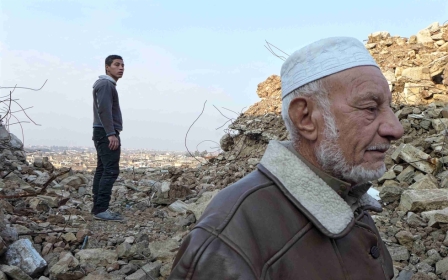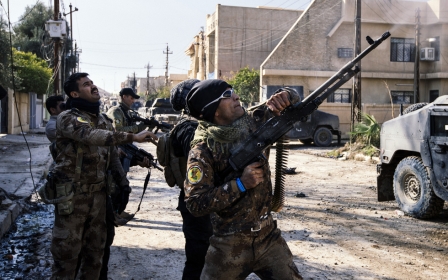Tunnels of terror: How Islamic State trained death squads under Mosul
MOSUL, Iraq - Illuminated by thin beams of light from soldiers' head torches and mobile phones, the climbing apparatus throws eerie shadows across the walls of the disused railway tunnel.
For almost three years, the high-roofed tunnel served as the Islamic State's training camp for its most elite fighters, capable of training up to 50 people at a time.
Running for 2.5km under dusty hills on the outskirts of southern Mosul, soldiers say the Palmyra Camp - named after the historic Syrian city - was the largest Islamic State training facility in Iraq.
It still houses equipment for IS recruits, who were put through a rigorous programme inspired by training for Special Forces personnel.
"This was very good training for special forces-type soldiers," Lieutenant Colonel Abdulemir al-Mohamed Alwi, media head for Iraq's elite Rapid Response Division (ERD), told MEE.
"They would have trained hard and well here, and would have come out as good fighters.
"But not everyone trained here. This was only for the elite Daesh [IS] forces, including the young ones called 'Caliphate cubs', and fighters being prepared for special suicide missions to attack behind enemy lines."
Disused railway became training camp
Once part of a railway network that ran from Mosul to Iraq's capital Bagdad, the tunnel lies 20km from the city centre on the outskirts of west Mosul's Abu Saif suburb.
It had fallen into disuse decades ago, even before Saddam Hussein took power in 1979, and was commandeered by IS after it seized control of the city in mid-2014.
Recognising its potential as a clandestine location far from residential areas, where training activities and high-level meetings could be held in secret, IS ripped out the old railway tracks and equipped the tunnel to accommodate groups of up to 50 fighters for weeks at a time.
Since the Iraqi army launched its long-planned Mosul offensive in October last year, IS has relied heavily on extensive networks of tunnels across Mosul and the surrounding area in their defence of what was formerly its Iraq stronghold.Although the Palmyra camp was completely hidden from aerial sight, air strikes blew up one of its entrances after surveillance recorded suspicious activity in the area as Iraqi forces advanced towards west Mosul. Within days, ERD ground forces were able to enter the premises, although access remained restricted until military engineering units had declared it safe.
"We have found a lot of tunnels and we expect we will find more, but this is by far the longest one we have discovered so far," said Ahmed, an ERD soldier.
Graffiti declares: IS heading for Rome
Evidence suggests the tunnel had been recently used - but ERD forces said no dead IS fighters have been discovered there. Despite the air strike demolishing one entrance, the interior was protected by extraordinary defences made up of chicanes of thousands of sandbags at either end of the tunnel. Concealed holes in the roof provided additional escape routes.
"We support the caliphate and we have friends all over the world who can fight," one threatens.
Ahmed, an ERD soldier, laughs as he reads out an inscription, declaring that IS is heading to Rome. "This is very stupid," he says contemptuously. "I love Rome. I don't want anyone to do to Rome what they did to Mosul. Leave Rome alone."
"No one could just come here and set this up without external support. But we just don't know for sure yet which countries supported this"
- Lieutenant Colonel Abdulemir Al-Mohamed Alwi
Discarded cardboard and metal targets reveal how IS recruits were trained with different weapons. Fighters were initiated by first firing pistols at a distance of 50 metres, before moving on to larger weapons and progressing to 300 metres.
Reinforced cement firing points, illustrated by a crudely-painted Kalashnikov, were used by trainees to practice accurate shooting and defence. Red painted arrows showed them where to place their guns to take aim at targets, before ducking back down under cover.
"We have no idea what it was but we know it was important because it was the only thing they burned while leaving a lot of other stuff intact."
Laminate maps of Mosul
At one end of the darkened tunnel, which formerly boasted electric light, running water and air conditioning, stand the smashed remains of the Palmyra Camp reception area, where new recruits would be screened, searched and registered. Beyond this lies the living quarters, with bathrooms and a large matted prayer area. A mosque is painted on the wall behind.
The floor of the reception area is littered with IS newspapers glorifying suicide operations and listing monthly casualties and losses from opposition forces, along with leaflets explaining methods for checking if people were "proper" Muslims.
ERD forces say that the discovery of the training camp has given them valuable insight into how IS fighters operate on the ground. A discarded laminated map of south Mosul districts, stripped of any area names, reveals how recruits were trained to move around without referencing place names, relying instead on a numerical system.
"Each number equates to a place or position which are listed in a separate book," explains Alwi. "They learn the numbers and can then find each other and communicate locations in secret."
He shows how some routes were marked out on the map with red and blue marker-pen crosses.
Such maps correlate with laminated cards listing numerical positions and the names of IS operatives holding these found near former IS sniper positions in liberated east Mosul.
Was there foreign support?
IS used professional tunnelling equipment to chisel large chambers into the sides of the tunnel to create sleeping quarters for trainees, the floors of which are scattered with tens of empty balaclava packets and army boot boxes.
There has also been both practical and financial support from abroad. "We think they had foreign fighters and trainers here, probably special forces soldiers from other countries," he says, heading towards the narrow strip of daylight that, since the air strikes, forms the only accessible route into the tunnel.
"No-one could just come here and set this up without external support. But we just don't know for sure yet which countries supported this."
This article is available in French on Middle East Eye French edition.
Stay informed with MEE's newsletters
Sign up to get the latest alerts, insights and analysis, starting with Turkey Unpacked
Middle East Eye delivers independent and unrivalled coverage and analysis of the Middle East, North Africa and beyond. To learn more about republishing this content and the associated fees, please fill out this form. More about MEE can be found here.











